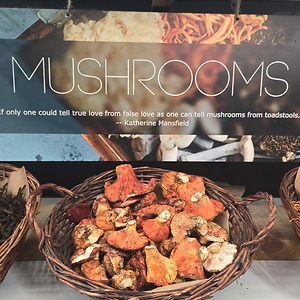


Lobster Mushrooms
Estimated Inventory, lb : 0
This item was last sold on : 03/03/25
Description/Taste
Lobster mushrooms are gnarled, contorted fungi, averaging 15-20 centimeters in diameter, and have an irregular shape with little to no stem and a cracked cap. The surface of the cap is textured, firm, and mottled, ranging in color from white to a vibrant orange-red, with split, wavy edges. Underneath the cap, the gills of the host mushroom almost disappear under the parasitic fungus, leaving the area somewhat rippled and disfigured. When sliced, the flesh is white, dense, and spongy with a faint, seafood-like aroma. Lobster mushrooms have a chewy texture with a subtly nutty, woody, and delicate flavor.
Seasons/Availability
Lobster mushrooms are generally available in the fall through early winter. In specific regions of North America, they can also be found as early as mid-summer.
Current Facts
Lobster mushrooms, botanically classified as Hypomyces lactifluorum, are fungi that have been compositionally altered by a parasitic mold. Research shows that the mold prefers the brittle white mushroom, Russula brevipes, and the peppery milkcap mushroom, Lactarius piperatus, as its host. The parasitic fungus propagates on the host, altering the mushroom’s chemical composition, and covers the surface in bright orange coating while twisting the cap into odd shapes. This contortion is noted in the Lobster mushroom’s scientific name, hypomyces, which is a Greek word meaning “mushroom underneath” as a nod to the process by which the Lobster mushroom is formed. Throughout this symbiotic process, the host mushroom, initially considered flavorless, improves in taste and texture when transformed, creating a desirable, rare fungus. Lobster mushrooms are not commercially grown and are foraged from the wild, favored for their dense consistency, mild flavor, and unique coloring.
Nutritional Value
Lobster mushrooms contain some fiber, which stimulates digestion, and copper, a nutrient that helps in the production of red blood cells and iron absorption. The mushrooms also provide lower amounts of vitamins B, D, and K to assist in maintaining overall health.
Applications
Lobster mushrooms must be cooked and are best suited for sautéing, braising, and baking. To clean, the fungi should be dry brushed to prevent the bright coloring from being removed. The mushrooms retain their firm texture after cooking and can be added to pasta dishes, mixed into chowders and soups, cooked in cream-based sauces, or added to stews and terrines. They can also be incorporated into risotto, seafood, omelets, and stir-fries. It is important to note that the red-orange coloring will bleed when heated, creating a rich hue, especially in rice-based dishes. In addition to cooked preparations, Lobster mushrooms can be dried for extended use, which intensifies their flavor. Lobster mushrooms pair well with onions, garlic, ginger, potatoes, orzo, spinach, broccoli, cauliflower, tomatoes, lemon, and cannellini beans. Once picked, the mushrooms should be used immediately for the best quality and flavor but can also be stored in a paper bag in the refrigerator for 3-7 days. Once cooked, it is imperative that the mushrooms be consumed within two days to avoid spoiling and food poisoning.
Ethnic/Cultural Info
Lobster mushrooms are used as a natural dye, capable of producing shades ranging from a pale orange to pink, and saffron, and can also create darker shades of purple or red depending on the additional ingredients added. The art of dyeing fabrics with mushrooms dates back to the early 1970s in Northern California when artist Miriam C. Rice began experimenting with local fungi varieties as a source of color. Rice used cotton, wool, and silk to absorb the varying colors and spent years documenting the shades of dye obtained from each variety of mushroom. In 1980, Rice published her research in her first book, “Mushrooms for Color,” and established the International Mushroom Fungi & Fiber Symposium, launching her career as an artist and researcher. Dyeing with mushrooms is still practiced worldwide in the modern-day, and in addition to fabrics, the dye created from Lobster mushrooms can also be used to color paper.
Geography/History
Lobster mushrooms are found wherever russula and lactarius mushrooms are grown, typically in temperate forests across the northern United States from the Pacific Northwest to New England and throughout Canada. It has been heavily debated whether Lobster mushrooms are found globally or are only found in North America, with some experts believing there are two separate parasitic species, while other experts claim the mold species is the same worldwide. Today Lobster mushrooms are foraged from the wild and can be found in limited supply at farmer’s markets and through select specialty grocers in the United States, Canada, and Europe.
Recipe Ideas
Recipes that include Lobster Mushrooms. One
Podcast

















